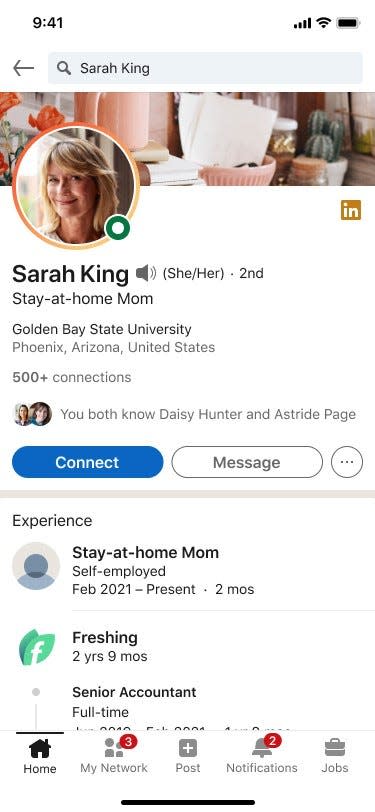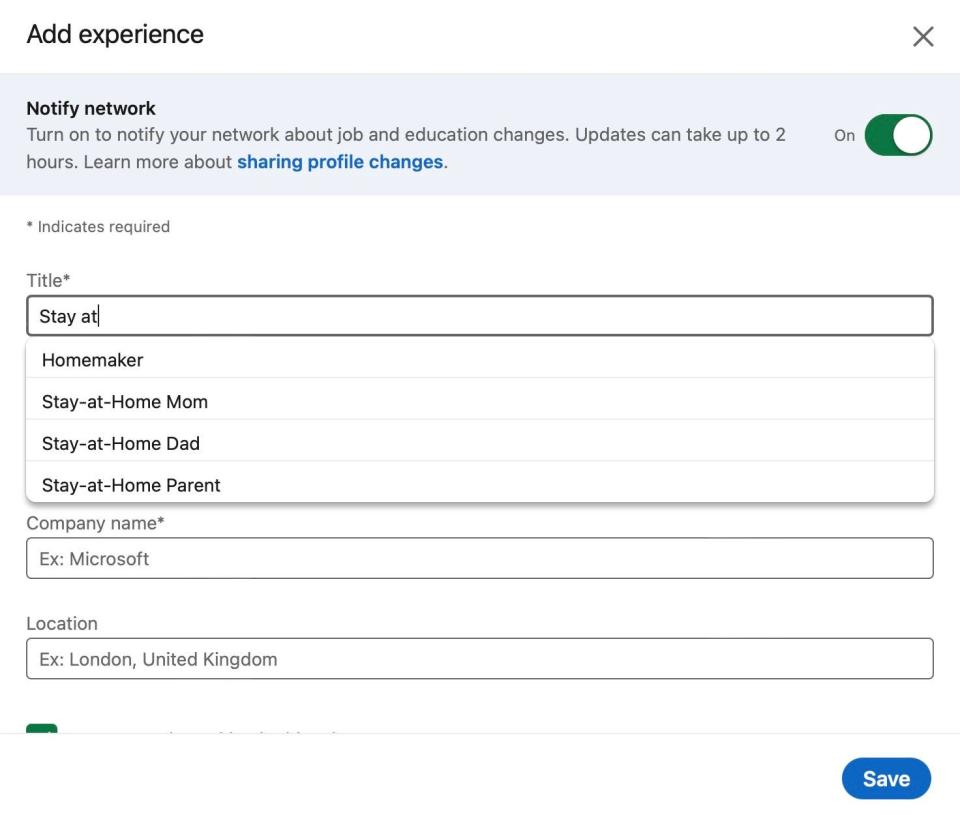
A few months ago, I was talking with a mom friend of mine who had not worked – outside of her home and the daily care of her four children, that is – since shortly after her first son was born 12 years ago. Before kids, she had not one but two gratifying careers, first as a schoolteacher, then as a registered nurse.
Through the parent grapevine, she heard about an opening for a school nurse at her oldest son’s school and wondered aloud whether she should apply. “That’s so perfect for you!” I exclaimed. “You’ve been talking about going back to work. … You’re going for it, right?”
“Are you kidding?” she said. “I have no references, no letters of recommendation. How do I even begin to explain not working for the past 12 years?”
TALKING TECH NEWSLETTER: Sign up for our guide to the week’s biggest tech news
While I assured her that no one in their right mind would think that raising four kids – including homeschooling during the pandemic, juggling schedules for four children ages 4 to 12 and attending to every single need to keep a human alive – was equivalent to “not working,” the latest employment numbers, survey data and some honest feedback from recruiters tell a different story.
Confessions from inside the she-cession

“When I talk with employers, I still hear ‘She just doesn’t really want to work,’ or ‘They just want to do something easy,’ says Sacramento-based strategic HR consultant and recruiter Anna King. As a mom of a 9-year-old son with special needs herself, King says that kind of outdated thinking is one of the main reasons for hiring shortages today.
Tami Forman, the executive director of Path Forward, a nonprofit dedicated to helping people reenter the workforce after time off for caregiving, agrees. “Women are discriminated against throughout their careers because of beliefs around caregiving and gender. Some employers are still having a hard time hiring from an incredibly talented pool of could-be workers and I want to say: ‘Maybe it’s time for you to catch up. Maybe what’s making it so hard for you to hire is your own bias,’” Forman tells me.
JOBS: Unemployment rate fell to 3.6% in March as jobs report showed big gain
In addition to several anecdotal accounts of ongoing bias, research shows that women still spend a disproportionate amount of time handling housework and child care responsibilities. When the pandemic struck, an overwhelming number pulled back from their professional ambitions, hit pause on careers they loved and gave up their paychecks and long-term goals. They left their jobs hoping that once the pandemic was over, things might get better.
Today, despite jobs charts showing upward trends across the board, there are still more than 1.1 million fewer women in the workforce than there were in February 2020. Meanwhile, there are nearly 500,000 more men in the workforce today over that same period.
“You meet people socially and they ask ‘What do you do?’ and when you answer ‘I’m a stay-at-home mom,’ the conversation just stops,” Emma McCulloch tells me over the phone. “There was such a stigma, especially in (Silicon) Valley and even a feeling of shame.”
McCulloch stepped away from a promising 15-year-long career in corporate communications to care for her two children nearly a decade ago. She said her priorities changed when her oldest son was diagnosed with autism and she took six years away from a traditional full-time job. Though she stayed active tackling challenging community-based communications roles – unpaid – she says that when she eventually tried to reenter the workforce, she faced several roadblocks. Mainly, she was worried managers would think she wasn’t serious – or even worse – that she had spent the past years doing “nothing.”
But could the world’s largest professional workforce network change that?
LinkedIn takes ‘significant step in normalizing parenting-based career gaps’
“Stay-at-Home Mom” is now an official job title, according to the world’s largest professional networking site, LinkedIn. The company also added “Stay-at-Home Dad” and “Stay-at-Home Parent” to the dropdown menu in the profile experience section about a year ago. This is a significant step in normalizing parenting-based career gaps.
“The pandemic has disrupted organizations and workplaces, forcing many people to take a break in their career, especially women,” says Suzi Owens, senior director of corporate communications at LinkedIn. “Even before the pandemic, we know that workers – women in particular – were fearful of discussing any gaps on their resume.”
One year in, it’s working so well that the company has gone a step further and added a “Career Breaks” option under the Experience section that now includes Bereavement, Caregiving (for an elderly parent or loved one), Layoff and even Relocation, among others.
The company hopes it can help remove the stigma attached to career gaps. It seems to be working.
‘It’s time’ we celebrate career breaks
“The response has been overwhelmingly positive,” Owens says. “I’ve seen so many conversations about what this means to people and helping to normalize career breaks. It’s been really, really amazing. We need to do more than normalize career breaks. It’s time we celebrate them. The new professional craves flexibility without worry that taking time away will halt or negatively impact their career and life trajectory. Because the reality is that these off-your-resume experiences are immensely beneficial, in and outside of the office.”
‘ID10T ERROR’: What are your company’s IT guys calling you behind your back?

“The idea that LinkedIn, in its outsized role as the arbiter of career path profiling, has created this category validates the choice to take a career break as a legitimate part of a longer career path,” says Carol Fishman Cohen, CEO and co-founder of iRelaunch.
Cohen also notes that “career break programming” is one of the hottest areas in human resources right now for all genders, not just women. “The pool is high-caliber, educated, with work experience, a mature perspective, stable life stage and enthusiasm about working again. Also, having lived life longer, they are more self-aware and fully formed as humans, with a keener sense of where they can add value at an employer.”
She got the job!
My friend is now a happily employed school nurse. She credits her relationships within her community more than any line items on a resume.
McCulloch also landed her “dream job” with online learning service and textbook provider Chegg. She says LinkedIn played a much more significant role for her. “It’s been amazing that you can now categorize these titles on LinkedIn and the stigma is hopefully moving,” Emma says. “It’s not that you took a career break because you’re a failure or bad performer or that you ‘don’t want to work.’ I don’t regret stepping away. It provided me with perspective and empathy. I am a stronger professional today as a result.”
How to add ‘Stay-At-Home Parent’ or other career breaks
If you’re on your LinkedIn profile page, it might not be immediately clear how to add these new features to your job and experience sections. Near the top of your profile, you’ll see a button that says “Add profile section.” Click that and then click the “Core” menu to open a list of things you can add. Here you can select “Add a career break” and then specify the reason for the gap in your resume and the time frame.
Adding a new position – including “Stay-at-home Mom/Dad/Parent” – is just like adding any other new job, but as a refresher: First, from your profile page, select “Add profile section” and then “Add position.” A new box will pop up with various fields. Under the Title field, begin typing “Stay-” and you’ll see the automated choices on the list. Pick the appropriate one and then add any other relevant info, just like you would for a traditional job role.
Jennifer Jolly is an Emmy Award-winning consumer tech columnist. Email her at [email protected]. Follow her on Twitter: @JenniferJolly. The views and opinions expressed in this column are the author’s and do not necessarily reflect those of USA TODAY.
This article originally appeared on USA TODAY: LinkedIn adds Stay-at-Home-Mom and Dad as official job titles





More Stories
Benefits of Building Muscle in a Home Gym – Working Out At Home To Develop Buff And Tuff Muscles
My Home Is My Sanctuary – Just As It Should Be – Do You Agree?
Stay At Home Moms